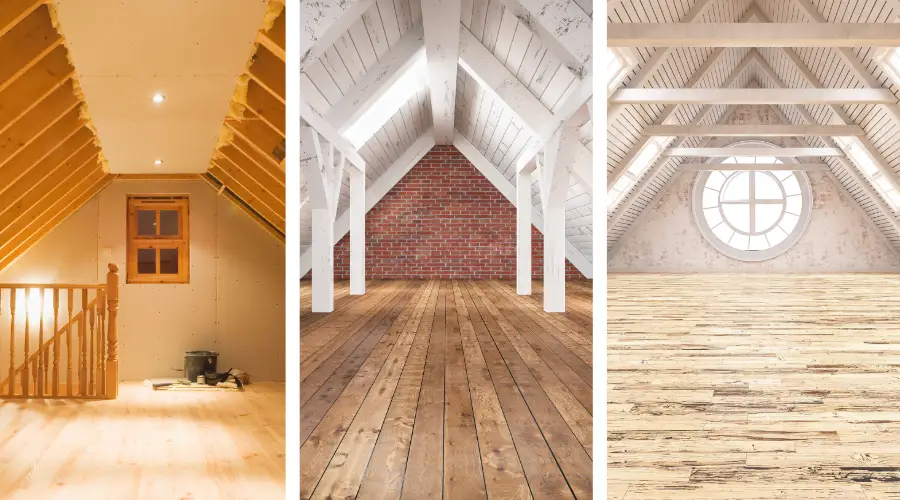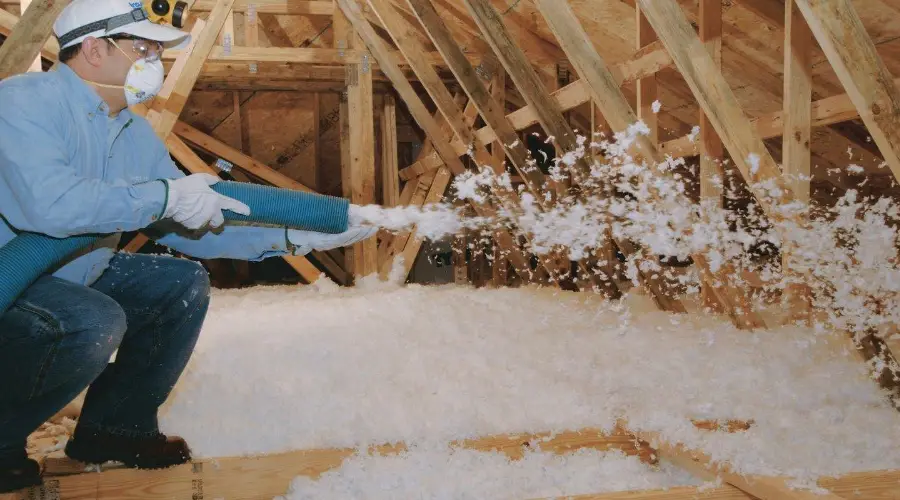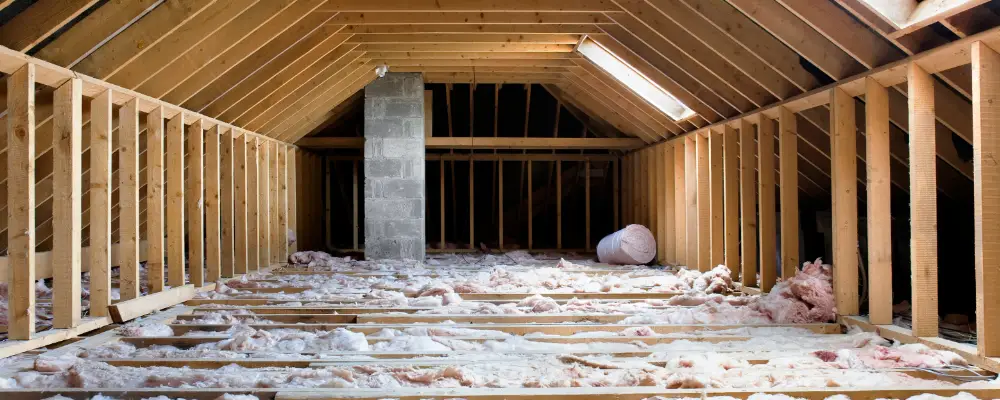Have you ever come home on a sweltering afternoon, only to find that you’ve walked into a sauna? Or do your electric bills jump in the summer and winter? If so, it could be an issue with your attic.
Attics are often ignored by many homeowners in India; however, they play a significant role in keeping your home cool, comfortable and efficient. That’s where attic insulation comes in.
This handy guide from Brick & Bolt is here to break down everything you need to know about attic insulation, including what it is, how it works, what types are available and if and why it’s worth your money.
What is Attic Insulation?
Attic insulation is a thermal barrier installed in the roof space of a building to reduce the transfer of heat between the living area and the outside environment. It helps maintain a balanced indoor temperature by minimizing heat gain during the summer and preventing heat loss in winter. This insulation plays a crucial role in energy efficiency, as it lowers HVAC system workload and reduces overall utility costs.
It is like a thermal shield for your home. When you have no insulation, you are forcing your air conditioners to work much harder, and therefore paying much larger energy bills. If you insulate your attic, you will be much more comfortable and stable at a consistent temperature year-round.
Types of Attic Insulation

Depending on your budget, climate, and method of construction, there are many kinds of materials to use for attic insulation. The following are the most commonly used in Indian homes and construction:
Heat-Resistant Sheets
Made from fiberglass or mineral wool, these sheets act like a thermal shield to slow down heat transfer from the roof into living spaces. They also resist fire and moisture—making them a reliable, budget-friendly option for hot climates.
Heat-Reflective Sheets
Featuring aluminum foil layers, these sheets bounce up to 95% of the sun’s radiant heat back outside, helping reduce attic temperatures by as much as 10–15 °C on sunny days. Lightweight and easy to install, they’re ideal for open-roof attics in warm regions.
Roof Insulation Boards
Available as rigid foam (EPS/XPS) or fibreglass boards, these provide steady insulation across your roof or attic floor. They help regulate temperature swings and reduce noise—popular in both homes and offices.
Roof Cooling Sheets
These are similar to foam or board insulations but come with UV-resistant coatings that reflect sunlight right off the surface. Excellent for withstanding harsh sun and keeping roof surfaces cooler—especially useful in consistently sunny parts of India.
Key Benefits of Attic Insulation
Here are some reasons to invest in attic insulation:
- Energy Efficiency
Attic insulation helps regulate the internal temperature of your home by limiting heat transfer through the roof. In the summer, it keeps hot air from entering; in winter, it traps warmth inside. This reduces the strain on air conditioners and heaters, making your home more energy efficient year-round.
- Lower Utility Bills
Because your heating and cooling systems won’t have to work as hard to maintain a comfortable indoor temperature, you’ll notice a drop in your monthly electricity bills. Over time, the savings from reduced energy consumption can help you recover your insulation investment.
- Improved Indoor Comfort
Insulation eliminates common discomforts like uneven room temperatures, various types of ceilings, or hot drafty zones. Whether it’s a blazing afternoon or a chilly night, a well-insulated attic creates a more stable and cozy living environment throughout the house.
- Noise Reduction
Many insulation materials—especially fiberglass and mineral wool—also offer soundproofing benefits. This can be especially helpful if your home is near a busy road, airport, or noisy neighborhood, as insulation helps muffle outside sounds for a quieter indoor atmosphere.
- Increased Property Value
Energy-efficient homes are increasingly in demand among buyers and tenants. A properly insulated attic not only adds to your comfort but also boosts your home’s resale or rental value by highlighting long-term savings and sustainability features.
- Environmentally Friendly
By cutting down on electricity use, attic insulation helps reduce your household’s carbon footprint. Lower energy demand means less fuel burned at power plants, which contributes to fewer greenhouse gas emissions and a healthier planet through sustainable construction methods.
How Attic Insulation Works

Heat flow is slowed by insulation material in three ways:
1. Conduction
This is the transfer of heat through solid materials. Since insulation is made of non-conductive materials like fiberglass or foam, it slows down the movement of heat through the roof and ceiling surfaces. Without insulation, heat would easily pass through solid materials into your home.
2. Convection
Convection refers to the movement of heat through air. Insulation traps small air pockets within its structure, preventing warm air from rising and circulating freely in the attic. This helps stop hot or cold air from entering living areas.
3. Radiation
Radiation refers to heat from the sun that travels in straight lines and strikes the surfaces within the attic. Reflective insulation, such as radiant barrier sheets, works by reflecting this radiant heat away from the attic room, thereby reducing heat buildup and keeping the attic cooler.
When you work on all three means by which heat transfers into your home, attic insulation will create a more consistent indoor temperature which will help to protect the wear and tear of your heating or air conditioning equipment, while making you feel comfortable and decreasing the energy bills.
How To Insulate an Attic?
It is not complicated to insulate your attic. An effective process and professional assistance make it an easy way to boost your comfort and energy savings. Here’s how:
Step 1: Initial Inspection and Thermal Assessment
Start by carefully inspecting your attic for any existing issues that could interfere with insulation performance. Look for air leaks around vent pipes, light fixtures, chimneys, or wiring holes. Check for signs of moisture, mold growth, or pest infestations—these must be resolved before proceeding. Using a thermal camera or infrared thermometer can help you identify cold or hot spots in the attic, indicating areas with poor insulation. Also, any old or damaged insulation should be removed, especially if it’s damp or deteriorated.
Step 2: Air Sealing
Air sealing is a crucial step that often gets overlooked. Even high-quality insulation can underperform if warm or cool air escapes through hidden gaps. Use expanding foam sealant to close wide openings around ducts and pipes, and apply caulk to smaller cracks along joists or framing. Install metal flashing with high-temperature caulk around chimneys to prevent fire hazards.
Don’t forget to weather-strip the attic hatch door to avoid heat exchange through entry points. Air sealing before insulation helps trap conditioned air where it belongs—inside your home.
Step 3: Choosing the Right Insulation Material
The type of insulation you choose should depend on your attic design, local climate, and budget. For Indian homes, reflective foil insulation or heat-resistant sheets are common under metal and concrete roofs to block radiant heat. Fiberglass batts or rolls are easy to handle and affordable, offering good thermal resistance. Blown-in cellulose is ideal for irregular attic spaces and provides better coverage.
For a more advanced solution, spray foam insulation offers superior air sealing and thermal resistance but must be installed professionally. Understanding each material’s R-value—the measure of its thermal resistance—will help you make an informed choice.
Step 4: Prepping the Attic Space
Once you’ve chosen your material, make sure your attic is clean, dry, and safe to work in. Remove any debris or stored items and ensure you can walk safely using wooden planks across the joists. To maintain ventilation and prevent moisture buildup, install baffles or rafter vents near the eaves. In colder climates or humid zones, consider adding a vapor barrier on the warm side (facing the interior) to reduce the risk of condensation forming within the insulation layers.
Step 5: Installing the Insulation
Installation should be done with precision to maximize effectiveness. If you’re using batts or rolls, place them snugly between joists, ensuring there are no gaps, overlaps, or compressed sections. For added insulation, a second layer can be installed perpendicular to the first. Blown-in insulation is applied using a machine that distributes the material evenly, forming a thick, fluffy blanket over the attic floor. If using radiant foil sheets, staple them to the underside of the roof, leaving a small air gap behind the foil to reflect heat efficiently. Aim to reach the recommended R-value for your climate zone—typically R-30 to R-49 in hot or temperate regions.
Step 6: Final Inspection and Cleanup
After installation, conduct a thorough inspection to ensure complete and consistent coverage. Verify that no vents are blocked and that all air gaps have been properly sealed. Check that insulation hasn’t shifted or compressed during installation. Attic rulers (depth markers) can be placed in a few spots to measure and monitor insulation depth over time. Ensure the attic access door is insulated and sealed well to prevent heat loss.
Step 7 (Optional): Attic Flooring or Storage Space
If you plan to use your attic for storage, don’t compress the insulation under heavy floorboards. Instead, build a raised platform using wood supports so that insulation can remain undisturbed underneath. This allows you to use the attic as storage while preserving the insulation’s performance.
Maintenance and Inspection
Although attic insulation involves very little maintenance, regular inspections can help prolong the life of the insulation and its performance for your home.
- Conduct Regular Inspections
Check your attic insulation every 12 to 18 months. Look out for signs of damage like moisture spots, mold growth, pest infestations, or flattened sections. Spotting these early can help you avoid costly repairs and energy loss.
- Protect Against Moisture
Water is one of the biggest threats to insulation. Any roof leaks or condensation in the attic can lead to soggy insulation, reducing its thermal resistance and encouraging mold. Ensure your attic remains dry and properly ventilated year-round.
- Avoid Compressing the Insulation
Placing heavy items on insulation can compress it, making it less effective. Insulation works by trapping air pockets, so any flattening diminishes its ability to resist heat flow. If storage is needed, consider installing raised attic flooring that doesn’t interfere with the insulation layer below.
- Consult a Professional When in Doubt
If you’re unsure what to look for during an inspection or suspect your insulation isn’t performing well, it’s best to call a professional. Trained experts can assess the insulation depth, condition, and coverage—and suggest repairs or upgrades if needed.
Cost Considerations
The cost of attic insulation can vary based on:
- Type of Insulation Material
Different materials come at different price points. For example, fiberglass batts are more affordable, while spray foam or reflective insulation tends to cost more due to advanced performance and specialized installation requirements
- Size of the Attic
The larger the attic, the more insulation material is required—and more labor too. A bigger area will naturally increase the total cost, especially if you’re aiming for a high R-value or dual-layer insulation.
- Labor Charges
Installation costs can differ based on whether you choose a professional service or DIY. Complex layouts or hard-to-access attics may require skilled labor, which adds to the overall expense.
- Location
Your geographic region also impacts the cost. Prices for both materials and labor vary from one city or state to another. Additionally, homes in hotter or colder zones may require higher levels of insulation, which increases material usage.
Conclusion
Attic insulation is more than just keeping the heat out; it’s about creating a more comfortable, more energy-efficient, and greener space. Whether you are building from scratch or retrofitting your current house or building, providing good insulation in your attic can be a wise decision for the future. A licensed professional like Brick & Bolt will do it properly, enabling you to enjoy its benefits for many years.

